I'm quite new to xcode, and I am trying to develop a sample app that is basically an embedded tableview which has many levels. I have a plist which stores the cells of each tableview. If the cells do not have children, then I want to be able to go to one detailed view once the cell is pressed. Eventually I want to be able to go to different detailed views depending on data type. To do this, I created a detailed view from storyboard, dragged my view controller to my detailed view to create a manual "Push" segue, and labeled the segue "segue1".
Edit: Source code here

Next I populate what I assumed to be the necessary functions for this to work, which is to call [self performSegueWithIdentifier:@"segue1" sender:myString]; where myString is the title of the cell I selected.
- (void)tableView:(UITableView *)tableView didSelectRowAtIndexPath:(NSIndexPath *)indexPath
{
//Check the dictionary to see what cell was clicked
NSDictionary *dict = [self.tableDataSource objectAtIndex:indexPath.row];
NSString *myString = [dict objectForKey:@"Title"];
NSDictionary *dictionary = [self.tableDataSource objectAtIndex:indexPath.row];
NSArray *children = [dictionary objectForKey:@"Children"];
//If there is no children, go to the detailed view
if([children count] == 0)
{
[self performSegueWithIdentifier:@"segue1" sender:myString];
}
else{
//Prepare to tableview.
DrillDownViewController *rvController = [[DrillDownViewController alloc] initWithNibName:nil bundle:[NSBundle mainBundle]];
//Increment the Current View
rvController.CurrentLevel += 1;
//Set the title;
rvController.CurrentTitle = [dictionary objectForKey:@"Title"];
//Push the new table view on the stack
[self.navigationController pushViewController:rvController animated:YES];
rvController.tableDataSource = children;
}
}
Finally, I called prepare for segue which looks for the segue labeled segue1.
-(void)prepareForSegue:(UIStoryboardSegue *)segue sender:(id)sender
{
if([[segue identifier] isEqualToString:@"segue1"])
{
DrillDownDetailController *dvController = [[segue destinationViewController] visibleViewController];
//DrillDownDetailController *dvController = [[DrillDownDetailController alloc] initWithNibName:nil bundle:[NSBundle mainBundle]];
[dvController setItemName:(NSString *)sender];
[self.navigationController pushViewController:dvController animated:YES];
}
}
I thought this would work, but for some reason, whenever the code reaches [self performSegueWithIdentifier:@"segue1" sender:myString];, it breaks with the error
***** Terminating app due to uncaught exception 'NSInvalidArgumentException', reason: 'Receiver () has no segue with identifier 'segue1'' * First throw call stack: (0x14b4022 0xeb4cd6 0xdf61b 0x3590 0xa85c5 0xa87fa 0x93d85d 0x1488936 0x14883d7 0x13eb790 0x13ead84 0x13eac9b 0x139d7d8 0x139d88a 0x17626 0x23ed 0x2355 0x1) terminate called throwing an exception(lldb)
I can't figure out why it's telling me it can't find segue1 when it's already defined in storyboard and the code.
